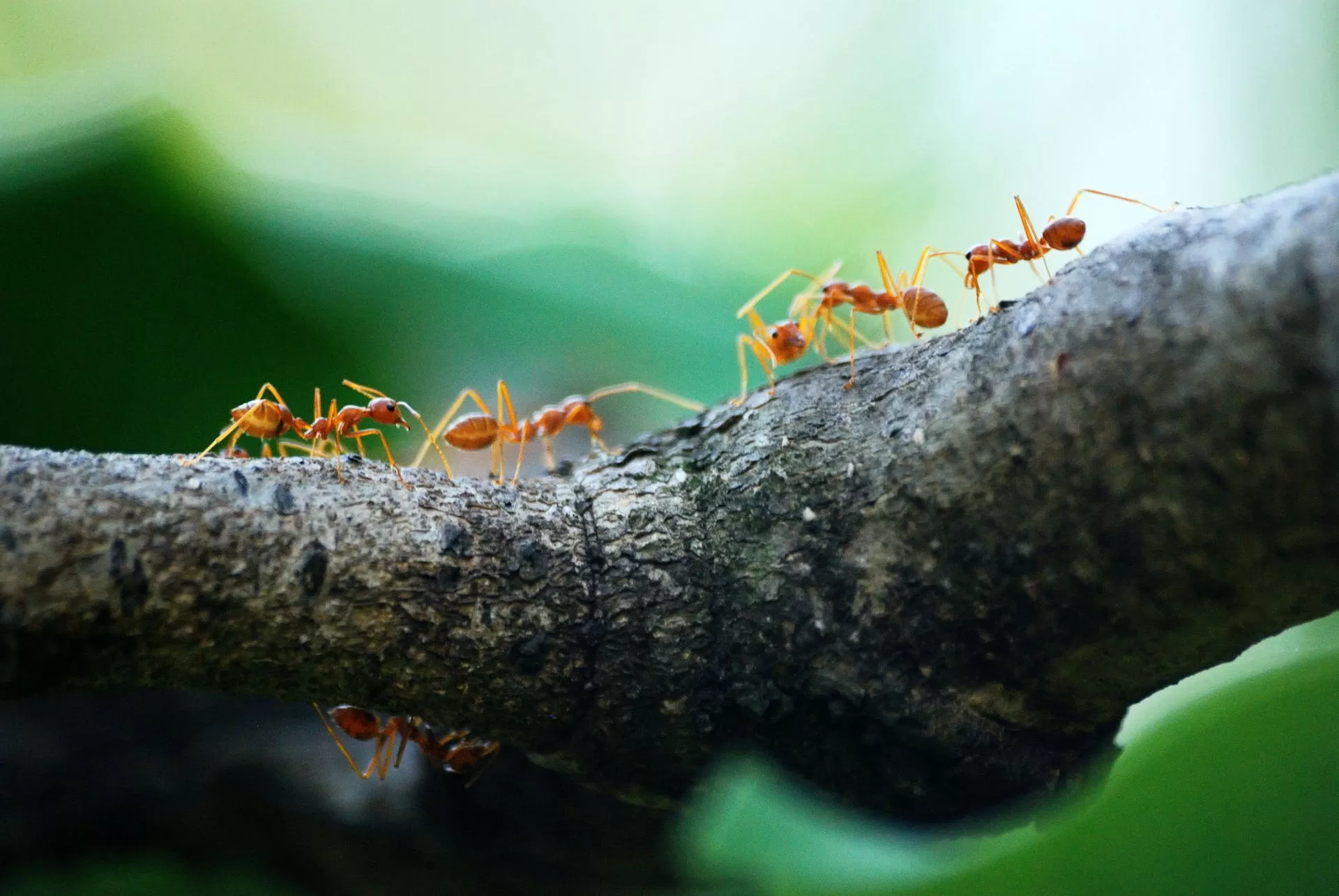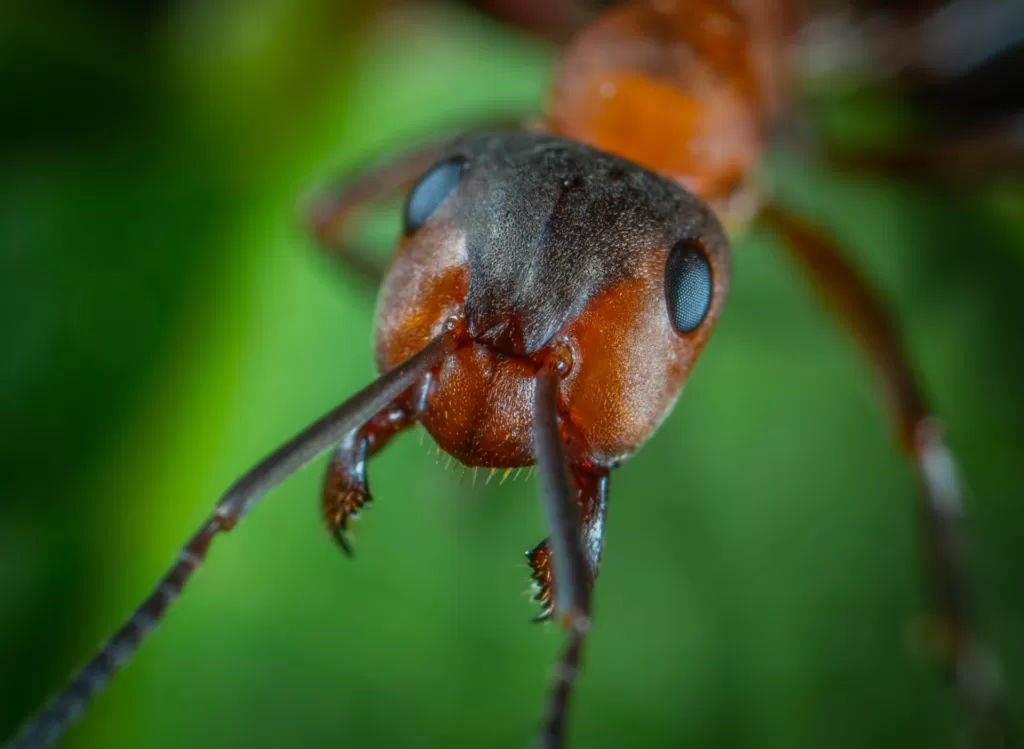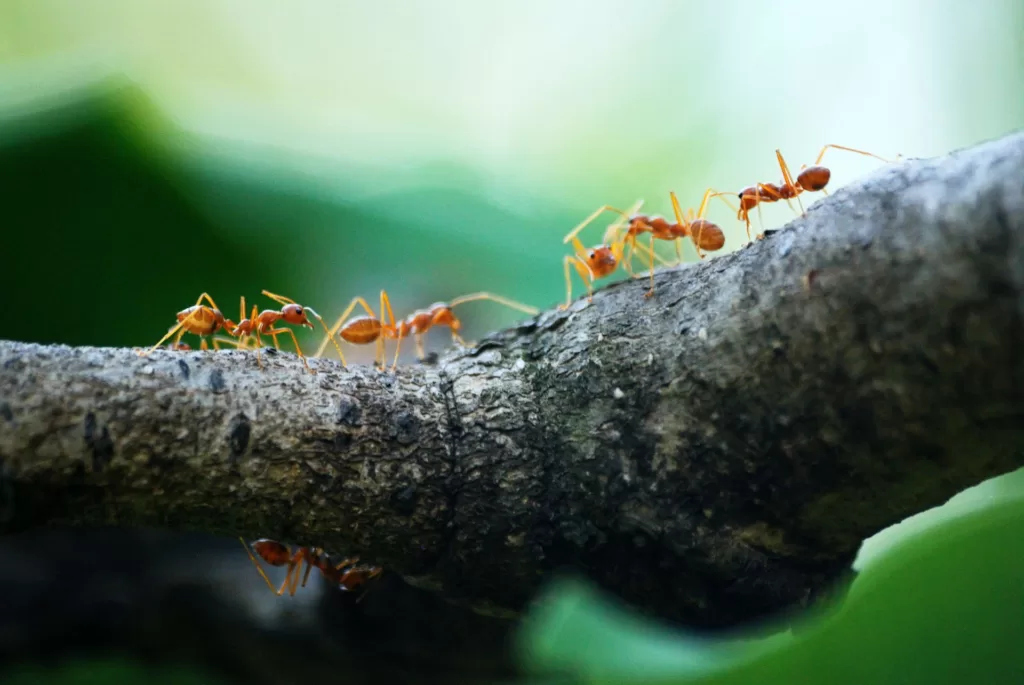Ants marching into your home can feel like an invasion, and the key to stopping them lies in understanding their behavior. Knowing how to spot the early signs of these uninvited guests means you can take action before they overstay their welcome. We’ll walk through sealing up entry points, which is a surefire way to keep ants outside where they belong.
Maintaining cleanliness goes a long way in ant prevention—crumbs are basically party invitations for ants. And when it comes to food storage? That’s crucial too. Properly sealed snacks mean no buffet for bugs.
If things get dicey, choosing the right baits and repellents becomes your next line of defense; knowing what type works best depends on who’s crashing at your place. Sometimes though, calling in pros trumps DIY efforts—it’s about knowing when to pick that battle.
Understanding Ant Behavior and Infestation Signs
If you’ve ever found yourself in an unwelcome dance with ants on your kitchen counter, you know the importance of spotting these tiny invaders before they throw a full-blown party. It’s all about cracking the code on ant behavior—knowing their secret handshakes and backdoor entries can save your home from becoming their next big hit.
Decoding Ant Trails and Nesting Habits
The thing about ants is that they’re master communicators. Their language? Pheromones. When one stumbles upon a sugar spill, it lays down an invisible pheromone trail straight to the motherlode for its buddies to follow. Spotting this conga line early can be as simple as noticing a lone scout or two—they’re the pioneers looking for new territories to colonize.
Nesting habits are another telltale sign. Most prefer cozy corners away from prying eyes: think wall cracks or under appliances. If you spot fine dirt or debris out of place, start thinking like an ant detective because there might just be more than meets the eye. Beeline Pest Control does a wonderful job decoding the trails, and habits, and getting rid of the root ant problem.
Early Warning Signs of Ant Infestations
Sometimes it feels like ants have a sixth sense for finding that one crumb you dropped weeks ago—but really, they’re just always on lookout duty (talk about commitment). A good rule of thumb is if you see more than three scouts around potential food sources, consider it RSVP confirmed; there’s likely an infestation brewing nearby.
You’ll also want to keep your peepers peeled for trails leading away from food spills—even pet bowls aren’t safe territory. These signs are nature’s way of whispering “heads up,” so take heed before those whispers turn into screams when armies march through every nook and cranny.
With some basic awareness about ant behavior, anyone can become quite adept at intercepting these little guys before things get out of hand—because let’s face it, nobody wants surprise guests taking over their living space.
Remember: Understanding what attracts them inside in the first place is half battle won against preventing future invasions by our not-so-friendly six-legged neighbors.
Sealing Entry Points for Effective Ant-Proofing
Picture this: You’ve just polished off a stunning meal, but the aftermath is an open invitation to some uninvited guests. I’m talking about ants – those little critters that sneak into your home through nooks you didn’t even know existed. It’s time we talk turkey on keeping these party crashers at bay by sealing up their favorite red carpet entrances.
Inspecting Doors, Windows, and Walls
A great place to start is where you’d least expect it. Did you know that ants can slip in through tiny cracks around doors or windows? Yeah, they’re sneaky like that. So grab a magnifying glass – metaphorically speaking – and inspect every inch of your doors and windows. Feel for drafts because if air can get out, ants can get in.
Finding gaps? Time to seal the deal with caulk or weatherstripping – think of it as putting a bouncer at each door who says ‘not tonight’ to any and trying its luck. And don’t forget the walls; patch up any cracks with spackle faster than you’d fill holes in your trivia team on quiz night.
The Importance of Ongoing Maintenance
Maintaining a fortress against ants doesn’t end with one round of DIY repairs; it’s more like painting the Golden Gate Bridge — once you finish, it’s time to start over again. Regular check-ups are crucial because let’s face it, houses settle and materials wear down over time creating new entry points for our six-legged foes.
To stay ahead of them, identifying potential problem areas early saves not only your pantry but also keeps stress levels low. Schedule seasonal inspections on your calendar next to family birthdays so neither gets forgotten.
Cleanliness is Key to Keeping Ants at Bay
Ants aren’t just looking for a place to crash; they’re on the hunt for their next meal. That’s why a kitchen that’s not up-to-snuff in the cleanliness department is like a five-star hotel for these tiny critters. But fear not, with some elbow grease and smart habits, you can send those ants packing.
Daily Cleaning Tips
Ant invasions start small—a few crumbs here, a sticky spill there—but before you know it, you’ve got an ant block party in your pantry. Studies have shown that food remnants are major ant attractants, so keeping your spaces crumb-free isn’t just neat; it’s necessary.
To tackle this head-on:
- Wipe down surfaces after each use—yes, even if all you did was make toast.
- Sweep or vacuum floors daily because what looks insignificant to us is an all-you-can-eat buffet for ants.
- Don’t let dirty dishes throw a rave in your sink overnight; wash them or load the dishwasher pronto.
Texas Beeline works on customized treatment plans and also offers a long-term treatment maintenance strategy making sure whatever they do stays intact for years.
Beyond feasting on our leftovers, ants need water too. So leaks might as well be neon “vacancy” signs flashing above your faucets. Patch up drips and dry out sinks and tubs after use—you’ll thank yourself later when you don’t find uninvited guests making themselves at home around moisture havens.
Maintaining order doesn’t stop at cleaning routines—it extends into decluttering territory as well. A cluttered house offers more hideouts where ants can establish their base of operations undetected until suddenly—they’re everywhere. The rule of thumb? Keep things tidy and minimalistic where possible because fewer hiding spots mean fewer chances of unwelcome six-legged roommates setting up shop.
The bottom line: Regular cleaning does wonders in creating inhospitable conditions for would-be intruders like ants who thrive off neglect—and nothing says ‘not welcome’ quite like sparkling countertops and spotless floors.
Smart Food Storage Solutions
Say goodbye to the days when a casual stroll to your pantry could turn into an unexpected meet-and-greet with ants. Proper food storage isn’t just about keeping your edibles fresh; it’s also a critical line of defense against these six-legged invaders.
Sealing Pantry Staples
The sweet scent of sugar and the rich aroma of grains might as well be a VIP invite for ants looking for their next feast. To keep them out, consider adopting airtight containers as your new best friends in the kitchen. Not only do they preserve freshness, but they’re like Fort Knox against ant invasions—no secret handshakes or passwords required.
A study highlighted that proper sealing is essential for ant-proofing your home. When you use containers that snap shut tighter than my Uncle Jerry’s wallet on his third date, you’ll find that even the most determined ants will have to look elsewhere for their sugar fix.
Pet Food Management
Your furry friend’s kibble might be gourmet fare in Montville—but not if you step up your pet food management game. Keeping feeding areas spick and span means cleaning up faster than kids scatter when chores are mentioned. An empty bowl is like tumbleweeds rolling through town—a clear sign there’s nothing left to see here, folks.
If Fido tends to graze throughout the day rather than gobble down meals at set times, then investing in ant-proof pet bowls can save both his lunch and your sanity. These nifty inventions usually feature water moats or other clever designs that create barriers tougher than trying to explain smartphones to 90-year-old grandparents—ants simply can’t cross them.
To sum things up without really summing them up because we don’t make conclusions around here: embracing these smart food storage tactics doesn’t just put an end to sharing breakfast with uninvited guests—it preserves peace of mind along with those perfectly crunchy granola clusters we all love so much. So let’s button up our pantries and show those ants who’s boss—one sealed lid at a time.
Choosing the Right Ant Baits and Repellents
Finding ants parading around your kitchen is like unwrapping a surprise gift you never wanted. It’s time to show them who’s boss, but with so many options on the shelves, how do you pick the winning ant baits and repellents? Let’s break it down.
Identifying Your Ant Species
Before setting out traps willy-nilly, remember that not all ants are created equal. The bait that lures one species might be snubbed by another. Knowing which type of six-legged squatters have moved in is key. Maybe they’re sugar-loving odorous house ants or protein-preferring carpenter ants—each has its own tastes.
To match the right product with your uninvited guests, study their size, color, and behavior—or snap a picture and get an ID online. Armed with this intel, selecting targeted weapons against these tiny invaders becomes much easier.
Different Bait Types for Different Ant Tastes
Baits come disguised as delicious snacks for ants but are actually Trojan horses carrying ingredients that will take down colonies from within. Granular baits work wonders scattered near outdoor nests while gel formulations can squeeze into nooks indoors where sprays fear to tread.
Selecting baits isn’t about guessing games; it involves a strategy akin to choosing chess moves against an insect opponent whose next move is predictable: find food fast. Use this predictability in your favor by placing baits along known ant trails—their efficiency relies on being easy finds for our tiny adversaries.
The Role of Repellents: An Invisible Shield
If laying out bait feels too passive for your taste then repellents may be more up your alley—they create barriers that tell ants “Keep off my turf.” These products range from natural essential oils like peppermint to synthetic pyrethroids designed specifically for perimeter defense against home invasions by pests.
An important tip when using repellents: don’t undermine their effectiveness by spraying them near baits—you’ll only confuse those little critters rather than lead them straight into your trap. A clear line between ‘no-go zones’ set up through repellent use and tempting bait stations ensures maximum impact on population control efforts within homes vulnerable to infestations.
Remember—it takes more than just picking any old product off the shelf when battling back bugs at home base (or should we say ‘home plate’?). Choosing correctly between various available solutions hinges upon understanding specific needs based on accurate identification of resident ant species coupled with smart placement strategies. Whether you go for baiting tactics or repellents, make sure your approach is tailored to target those pesky intruders effectively.
Professional Pest Control Services vs. DIY Methods
When ants crash your picnic, it’s an annoyance; when they invade your home, it’s a war. Deciding whether to don the general’s hat and tackle ant invasions yourself or call in the cavalry—professional pest control services—is a crucial decision.
Understanding Ant Behavior and Infestation Signs
To win any battle, you need to know your enemy. In this case, that means understanding how ants operate. They’re not just wandering solo—they follow pheromone-marked trails made by scout ants which lead directly back to their colonies.
If you’ve spotted these scouts or discovered their well-traveled paths on countertops or along baseboards, congratulations—you’ve got early intel on an impending infestation.
Sealing Entry Points for Effective Ant-Proofing
Your first line of defense is cutting off access points. A meticulous inspection around doors, windowsills, and walls can reveal tiny cracks where armies of ants breach defenses undetected. By sealing these gaps with caulk or weatherstripping—not exactly rocket science but surprisingly effective—you block the main roads into Fort Home Sweet Home.
Cleanliness is Key to Keeping Ants at Bay
You might have heard cleanliness is next to godliness. Well in pest control terms—it’s absolute truth. Regular cleaning eradicates food crumbs and spills that are like five-star Yelp reviews for your kitchen from an ant’s perspective.
Smart Food Storage Solutions
Beyond keeping surfaces spotless lies another strategy: smart storage tactics as simple as sealable containers keep pantry staples out of antennae reach while pet owners find salvation in ant-proof bowls—an unexpected hero in this saga.
The Right Tools: Choosing Your Weapons Wisely
Ants aren’t one-size-fits-all adversaries so neither should be our weapons against them. Different species require different approaches—from gel baits that invite unsuspecting workers over for a lethal dinner party inside their colony right down to granular barriers creating no-pass zones around homes.
Ant identification guides online help pinpoint foes’ identities ensuring we choose the correct armaments wisely—a key tactical advantage.
So what happens when despite best efforts those pesky six-legged intruders still break through?
That’s why bringing in professional exterminators can be a game changer. For instance, Idaho Beeline is known for its ant control management services. They’ve got the expertise and tools that most of us just don’t have access to. Think of them like pest control ninjas; they come in, assess the situation, and deploy specific treatments tailored to nix your particular bug problem for good.
Conclusion
So, you’ve learned the drill. Start by scouting out those early ant signs—like trails and lone scouts. Seal up any cracks to cut off their paths into your home. Keep it clean; remember, a crumb-free floor is no picnic for ants. Smart storage? It’s non-negotiable in ant-proofing your home—airtight containers are your best friends here.
Pick the right bait, because not all uninvited guests are alike. And if things escalate beyond a DIY fix, don’t hesitate to call in the cavalry—that’s what pros are for. This isn’t just about battling bugs; it’s about peace of mind in knowing you’re keeping your space pest-free—the smart way.
FAQs(Frequently Asked Questions)
To win any battle, you need to know your enemy. In this case, understanding ant behavior and identifying infestation signs is crucial. Ants communicate through trails and nesting habits, so it’s important to decode their patterns and habits to effectively combat infestations.
Ants have a sixth sense for finding food, so if you notice a sudden influx of ants in your home, it’s likely an early warning sign of an infestation. Keep an eye out for trails of ants, especially near food sources, as this could indicate a larger problem.
Your first line of defense is cutting off access points. By inspecting doors, windows, walls, and other potential entryways, you can identify and seal off these points to prevent ants from marching into your home.
Cleanliness is key to keeping ants at bay because they are constantly on the lookout for food sources. By maintaining a clean environment and daily cleaning habits, you can significantly reduce the likelihood of ant invasions in your home.
Smart food storage solutions involve keeping pantry staples sealed in airtight containers and managing pet food properly. By eliminating easy access to food sources, you can discourage ants from entering your home in search of a meal.
If DIY methods have proven ineffective or if the infestation is particularly severe, it may be time to consider professional pest control services. Pest control experts have the knowledge and tools to tackle even the most stubborn ant infestations.












